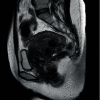Diagnosis of Leiomyosarcoma after Uterine Artery Embolization for Multiple Leiomyomas
- PMID: 33204553
- PMCID: PMC7655246
- DOI: 10.1155/2020/8823428
Diagnosis of Leiomyosarcoma after Uterine Artery Embolization for Multiple Leiomyomas
Abstract
Uterine sarcoma is significantly rarer than leiomyoma and has poor prognosis. Moreover, the diagnosis of leiomyosarcoma is difficult because its symptoms, including pelvic pain, uterine mass, and/or uterine bleeding, are very similar to those of leiomyoma. There are a few cases of leiomyosarcoma wherein leiomyoma was treated with uterine artery embolization (UAE); these reports revealed that the symptoms of hypermenorrhea or/and pelvic pain persisted even after UAE. Symptoms persisting even after UAE treatment for leiomyomas, especially multiple leiomyomas, should be investigated to rule out leiomyosarcoma. Therefore, long-term follow-up is needed. Here, we describe a case of a 39-year-old woman diagnosed with leiomyosarcoma 3 years after undergoing UAE for multiple leiomyomas.
Copyright © 2020 Maako Tsuji et al.
Conflict of interest statement
The authors declare that they have no conflicts of interest.
Figures



Similar articles
-
Leiomyosarcoma with dedifferentiation in a premenopausal patient discovered after uterine artery embolization.Pathol Int. 2007 Oct;57(10):681-7. doi: 10.1111/j.1440-1827.2007.02157.x. Pathol Int. 2007. PMID: 17803657
-
Literature review of outcomes and prevalence and case report of leiomyosarcomas and non-typical uterine smooth muscle leiomyoma tumors treated with uterine artery embolization.Eur J Obstet Gynecol Reprod Biol. 2015 Aug;191:130-7. doi: 10.1016/j.ejogrb.2015.05.018. Epub 2015 Jun 11. Eur J Obstet Gynecol Reprod Biol. 2015. PMID: 26117442 Review.
-
[Role of magnetic resonance imaging (MRI) in establishing the indication for, planning, and following up uterine artery embolization (UAE) for treating symptomatic leiomyomas of the uterus].Radiologe. 2003 Aug;43(8):624-33. doi: 10.1007/s00117-003-0929-0. Radiologe. 2003. PMID: 14504762 German.
-
Development of a Model for the Prediction of Treatment Response of Uterine Leiomyomas after Uterine Artery Embolization.Int J Med Sci. 2018 Nov 23;15(14):1771-1777. doi: 10.7150/ijms.28687. eCollection 2018. Int J Med Sci. 2018. PMID: 30588202 Free PMC article.
-
Role of magnetic resonance imaging in patient selection for uterine artery embolization.Acta Radiol. 2006 Dec;47(10):1105-14. doi: 10.1080/02841850600965047. Acta Radiol. 2006. PMID: 17135018 Review.
Cited by
-
Comparison of the diagnostic accuracy of contrast-enhanced/DWI MRI and ultrasonography in the differentiation between benign and malignant myometrial tumors.Ann Med Surg (Lond). 2021 Sep 21;70:102813. doi: 10.1016/j.amsu.2021.102813. eCollection 2021 Oct. Ann Med Surg (Lond). 2021. PMID: 34691413 Free PMC article.
References
-
- Parker W. H., Fu Y. S., Berek J. S. Uterine sarcoma in patients operated on for presumed leiomyoma and rapidly growing leiomyoma. Obstetrics and Gynecology. 1994;83:p. 414. - PubMed
Publication types
LinkOut - more resources
Full Text Sources

